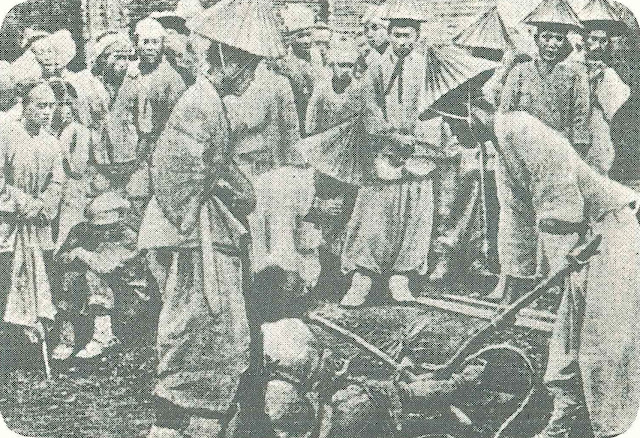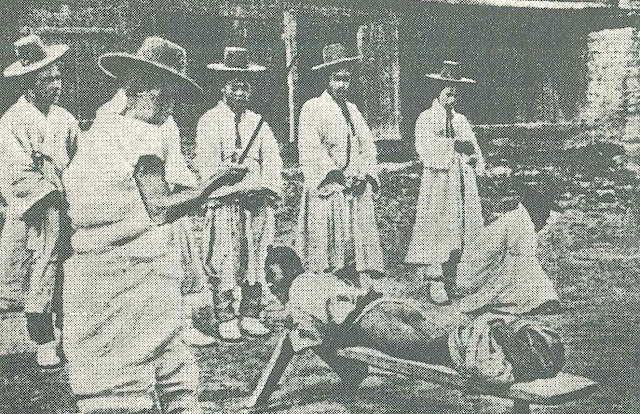In the Yi Dynasty of Korea, an executioner executed a prisoner by strangling him after torturing him to break his lower limbs and chest. Around him, onlookers watched with interest. They used a silk string to strangle the prisoner to death after breaking both legs and arms with thick sticks that also completely fractured the prisoner until he was executed. The rope used to tie the condemned prisoner was used to tie the prisoner's lower limbs into a kink. Both arms were tied to the side of the body so that the prisoner could not move an inch. The executioner placed a stick in the condemned man's lower limbs and placed his entire body weight on the end of the stick. The prisoners let out a series of fierce screams. As soon as the lower leg was broken, the blood drained from the condemned man's face, he broke out in a cold sweat and fainted, and the tremendous screams stopped. The executioner put a stick between the prisoner's arm and ribs and fractured them in the same way. Finally, using a silk cord, he strangled the prisoner to death. The body was dragged away for disposal.
Confession was the key to investigation in Joseon during the Yi Dynasty. Identify the suspect through canvassing the surrounding area. The suspect was arrested and a confession was extracted through torture. Many people made false confessions due to whipping and other blame, and many died because they could not endure the torture.
In Korea before the Japanese occupation, there was a privileged class of aristocratic blood relatives called "Ryobans" at the top. To become a yobang, one had to pass a Chinese-style examination, the Kekyoku. Ryobans regarded physical labor as a despicable behavior and studied only Chinese studies such as Confucianism. Ryobans never carried any weight and disliked physical activity. Rather than chopsticks and books, both groups received land and rewards from the state. As high-ranking officials, they formed the upper class. They privatized vast tracts of land through various appointments. Due to the corruption in the later years of the Yi Dynasty, the positions of both groups were sold for money. Once the Koreans had achieved their status through money, they exploited the lower classes for luxury. The rest of the citizens suffered and lost their incentive to work. The second class from the two groups, called the Jungjin, was formed mainly by professionals such as translators and scholars. They conducted practical business for the two groups. The third class, called everyman, consisted of farmers and those involved in commerce and industry.
In Korea before the annexation of Japan and Korea, foreigners saw and wrote about the life of the Korean people. He is a keen observer of the social life of modern Koreans. A Swedish citizen, Arson Glebt, recorded the Korean situation. The aristocracy of Joseon at that time was the most powerful and very arrogant. The aristocratic class of Joseon, the Ryobans, behaved like rulers or tyrants. They sent their men to exploit the merchants and farmers until they ran out of money and goods. If they gave money or goods, the merchants and farmers would be released, but if they did not, they would be taken to a camp where they would be imprisoned and not given any food. They were whipped daily until they paid the amount of money and goods demanded by the two groups. Even the good people among the two groups more or less disguised their thievery in the form of borrowing from themselves. No one was fooled by this, but they were let off the hook for their misdeeds. No one was fooled by this, but they were left to their own devices. When they bought fields and houses from farmers, they exploited them with little or no payment. Moreover, there was no one to protect them from this robbery.



